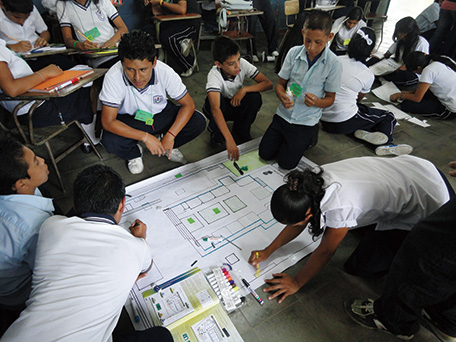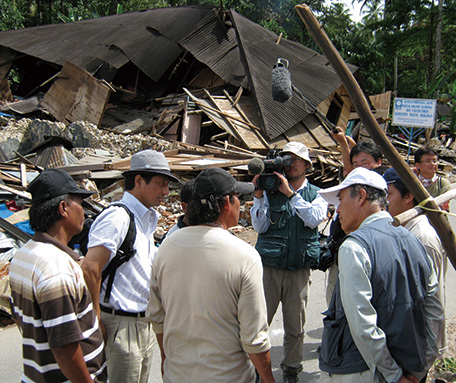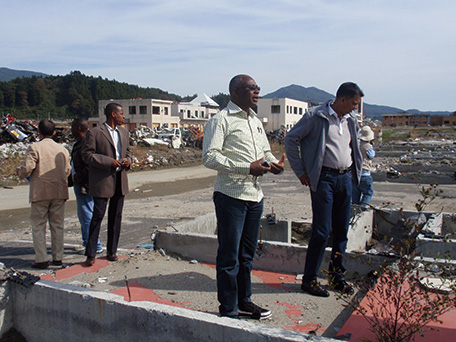Japan's Official Development Assistance White Paper 2012
Part II Building Resilient Societies – Japan’s Disaster Risk Reduction Cooperation
Chapter 1 Transmitting Disaster Risk Reduction to the World

Junior High School Students in El Salvador making a school disaster risk reduction map. (Photo: Maria Eva Oltiz/Oscar Mauricio Djebel/JICA)
Section 1 Sharing the Lessons of the Great East Japan Earthquake with the World
On March 11 2011, a massive earthquake of magnitude 9.0 struck off the Pacific coast of the Tohoku region causing an unprecedented disaster of the Great East Japan Earthquake. The dead and missing totaled approximately 19,000 people, around 130,000 homes were totally destroyed, displaced people directly after the quake numbered approximately 470,000 and the total cost of the damages was a massive ¥16.9 trillion. In response, countries and regions around the world sent a great deal of assistance such as contributing emergency supplies, monetary donations, and dispatching rescue teams. Sharing the lessons Japan learned from the earthquake with the world and contributing to disaster risk reduction efforts across the globe is also a way of responding to the wholehearted support received from around the world at the time of the earthquake and the tsunami.
In the following year, over two days on the 3rd and 4th of July 2012, it was with great significance that the "World Ministerial Conference on Disaster Reduction in Tohoku" was held in the Tohoku region, and centered in Sendai City which is also within the area affected by the earthquake the previous year. Participation in the conference was seen from around 500 representatives from 63 countries (such as the high-level participation of Foreign Ministers and Disaster Management Ministers) including 14 representatives from international organizations, as well as representatives from international/domestic NGOs and the private sector.

Plenary meeting in Sendai of the "World Ministerial Conference on Disaster Reduction in Tohoku"
In his opening remarks, former Prime Minister Noda said that Japan has a serious responsibility to the humanity at large to share the knowledge, experience and lessons learned from the earthquake with the international community, and also in the sense of "reciprocating" to the support and encouragement received from around the world at the time of the earthquake, Japan will contribute to the international community committing $3 billion for three years from 2013 in the area of disaster risk reduction as a contribution to international community. Similarly there were also reports on the experiences and lessons learned from Prof. G. L. Peiris, Minister of External Affairs, Sri Lanka regarding the earthquake off the coast of Sumatra and the tsunami in the Indian Ocean, and from Gerry Brownlee, Minister for Canterbury Earthquake Recovery, New Zealand regarding the earthquake in the southern island of New Zealand.
On the topic of the Great East Japan Earthquake, two female students from Onagawa Daiichi Junior High School in Miyagi Prefecture gave a presentation to the world of messages and thoughts for the coming generations as "Deepening mutual ties," "Creating cities enabling residents to evacuate to higher ground," and "Recording the Earthquake," which they had brainstormed during discussions held about their own actual harsh experiences.
In Ichinoseki City, Iwate, Ishinomaki City, Miyagi and Fukushima City, Fukushima, breakout sessions were held wherein issues were discussed such as the ideal form for resilient societies; the importance of disaster risk reducation in preparation for disasters; the collaboration required among relevant stakeholders over a wide-ranging area in the aftermath of a disaster; and handling disaster risks such as global warming and urbanization.
The details of the discussions from the two days of the Conference were presented as the Chair's Summary. The main points of the Summary are as follows:
- By prioritizing disaster risk reduction efforts, ensuring governance mechanisms for disaster risk reduction, and allocating sufficient financial resources, resilient societies should be built that are well-prepared for natural disasters in every way within all levels of public policy (mainstreaming disaster risk reduction) including disaster prevention and reduction, emergency response, recovery and reconstruction.
- Human security (See this) centered on human dignity should be a crucial foundation of disaster risk reduction efforts. Consideration of the members of society in vulnerable positions in terms of coping with a disaster, such as the poor, the elderly, the sick and wounded, children, persons with disability, and pregnant women is crucial. The role of women in disaster risk reduction should be properly recognized.
- Disaster risk reduction capabilities should be maximized by appropriately combining structural ("hard") measures such as infrastructure and non-structural ("soft") measures such as education, in accordance with particular national or regional needs.
- Collaboration beyond the roles of various stakeholders is indispensable, such as: assistance between local governments; strong coordination links between local and national governments; support by the businesses community supplementing the public sector; coordination among non-governmental organizations (NGOs); coordination between NGOs and the government; and cooperation between governments and media in disseminating and collecting information in times of disasters as well as following up on recovery processes.
- It is necessary to appropriately respond to newly emerging disaster risks in recent years which have significantly raised the cost of disasters in disaster prone areas such as the concentration of advanced industries, urbanization and climate change.
- Looking ahead from 2015 onwards, frameworks which incorporate disaster risk reduction should be drawn up to replace the MDGs, as new frameworks to take over from the truly effective “Hyogo Framework for Action 2005-2015.”
Through the World Ministerial Conference on Disaster Reduction in Tohoku, Japan proposed the "Disaster Reduction in the 21st century" which consists of these main elements, and expressed its determination to take the initiative in the international community's disaster risk reduction efforts in the future.

Damage survey of the 2009 off-shore earthquake in Padang, Indonesia. In relation to research to promote building resilient social foundations against disasters, Japan is collaborating with Indonesia's disaster risk reduction researchers, and is creating a system to put research results into practice. (Photo: JICA)

Participants in the Disaster Management Seminar from Africa observing downtown Rikuzentakata that was swept away by the Tsunami. (Photo: JICA)
